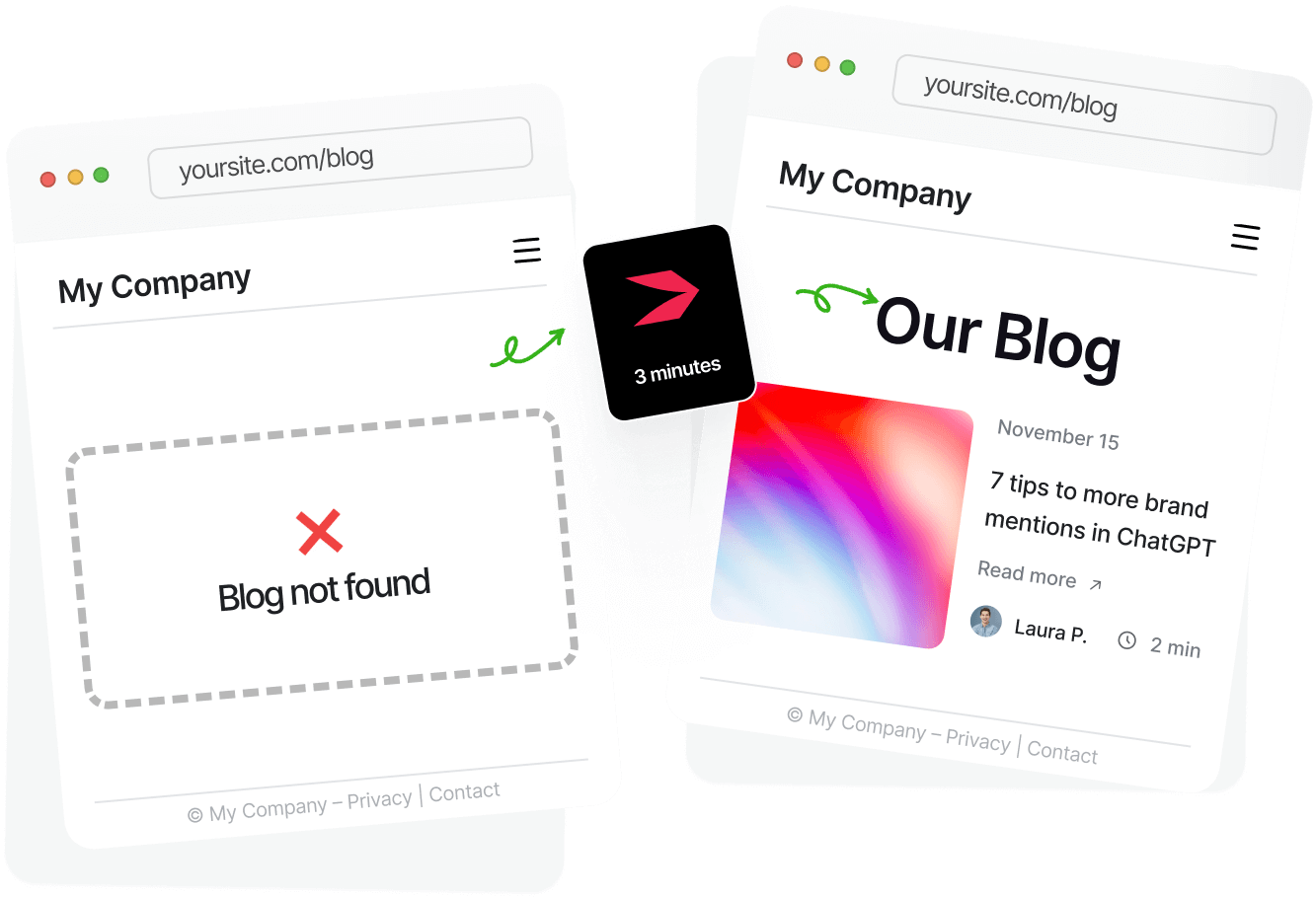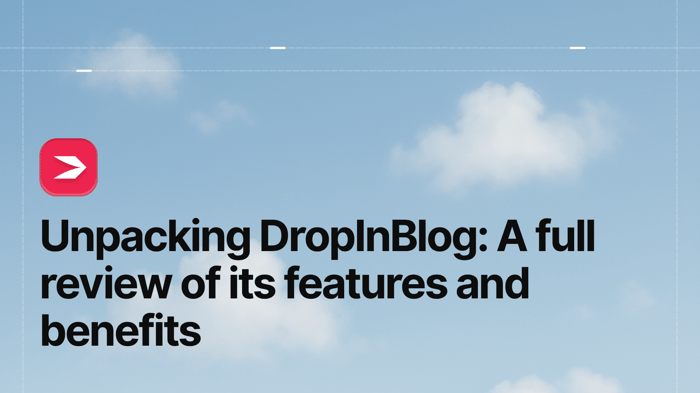Teachable, Shopify, Netflix, and HubSpot are all SaaS (Software as a Service) companies, and they all rely on blogs to drive traffic, educate users, and build trust at scale. For SaaS brands, blogging isn’t just a content strategy – it’s a key growth channel.
But when it comes to how they blog, their choices vary widely. Shopify uses its own blogging engine, Netflix has a blog on Medium, and Teachable uses Webflow. These companies don’t just blog – they rely on strategic blogging platforms that align with their marketing goals, growth plans, and SEO needs.
But not all platforms are built with SaaS in mind. Some are too rigid. Others are too complex. Some don’t support modern SEO or team collaboration.
So how do you choose the best blogging platform for your SaaS business? Easily! Continue reading to get a detailed view of DropInBlog, WordPress, Webflow, and more – to help you find the right fit for your growth stage, goals, and tech stack.
Table of Contents
Key Considerations for SaaS Blogging Platforms
The blogging platform of your choice should meet the following criteria:
1. Scalability and Performance
The SaaS blogging platform of your choice must support your growth. As your blog grows, you’ll have more content and traffic, and your platform should allow you to expand in both directions.
Look for a solution with content delivery network (CDN) support, image optimization tools, lazy loading, and any other features that will help your blog run fast.
2. SEO Capabilities
For your blog to appear in search engine results, you need a solution that allows you to optimize your content for Google and other search engines.
The most basic SEO features are metadata and URL customization.
The more advanced SEO features include on-page SEO assistance, image SEO settings, and link relationship attributes. Make sure your blogging tool supports both basic and advanced SEO features.
3. Integration with existing tools (CRM, analytics, etc.)
If you already have a list of tools that help you meet your objectives, you should look for a solution that will blend in with your existing stack.
Some blog platforms will have built-in analytics, but if there’s an analytics tool that gives you better insights, you should first check which blogging platforms integrate with that tool.
4. User roles and permissions for team collaboration
37% of SaaS companies have 11 to 50 employees – if yours is one of them, you’re probably juggling content, SEO, and design projects, and need a way to collaborate across teams.
Look for a blogging tool that lets you invite team members.
Check if the selected platform supports customizable permission-based roles so that you can control who has access to what.
Top Blogging Platforms for SaaS Companies
1. DropInBlog
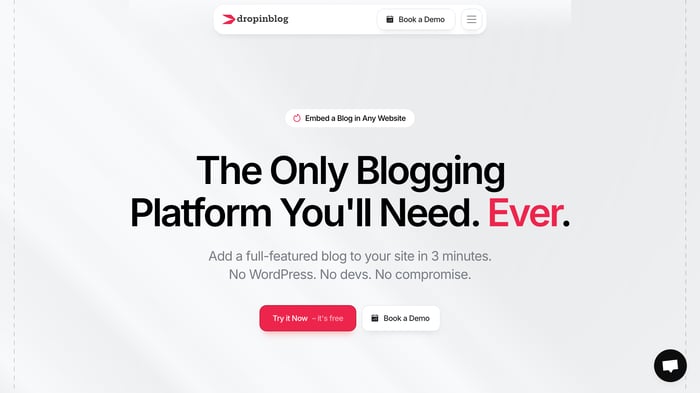
DropInBlog is one of the best blogging platforms recommended by e-learning platforms like Thinkific and a preferred blogging app for Shopify store owners. It works with website builders, e-commerce platforms, and HTML/CSS sites. So, if the platform you’ve used to create your site doesn’t have a built-in blog or the blogging feature is rudimentary, you can use DropInBlog to add a professional blog to it.
DropInBlog Key Features
SEO-friendly blogging tool: The SaaS blogging tool comes with a built-in SEO analysis tool, allowing you to not only create your content easily but also make it more visible in search results and AI overviews.
Blog Voice AI™: DropInBlog’s native text-to-speech engine provides your readers with a podcast-like experience. It automatically generates audio files whenever you add or update your blog posts.
Smart Snippets™: As your blog grows, you need a way to keep all your content up-to-date. With reusable content blocks that are updated across all instances at once, you can keep up with this task.
Works with the tools you already use: The platform integrates seamlessly with the tools you already use to run your business. Additionally, it integrates with Google Analytics, allowing you to monitor the performance of your content from your DropInBlog account.
Multi-user support: If you have writers, editors, and SEO specialists on your team, you can invite them to help you run your blog. DropInBlog supports permission-based roles, allowing you to create custom ones to ensure that everyone on your team has access to your blog.
Scalable: DropInBlog is the perfect solution for blogs of all sizes. It supports your blog’s growth without usage limitations and offers pricing plans tailored to different requirements.
Limitations of DropInBlog
Paid blogging tool: One of the potential drawbacks of this SaaS blogging tool is that it doesn’t have a free plan. On the other hand, you can always use its free trial to assess its features before starting your blog there.
Not a full CMS replacement: DropInBlog is built specifically for blogging – not as a full content management system. So while it’s excellent for content marketing, you’ll still rely on your main website platform for other functionality like landing pages or documentation.
Pros and Cons of DropInBlog
| Pros | Cons |
|---|---|
| ✓ Built-in SEO analysis tool | ✗ Paid blogging tool |
| ✓ Works with your existing tools | ✗ Advanced customization requires CSS knowledge |
| ✓ Scalable blogging solution | |
| ✓ Can be easily added to any website | |
| ✓ Supports reusable content blocks for simplified content updates | |
| ✓ Creates audio files from your blog content | |
| ✓ Boosts your blog’s visibility in AI searches | |
| ✓ One-click customizations with live preview |
Ideal for professional blogs of all sizes and all industries, including SaaS companies.
2. WordPress
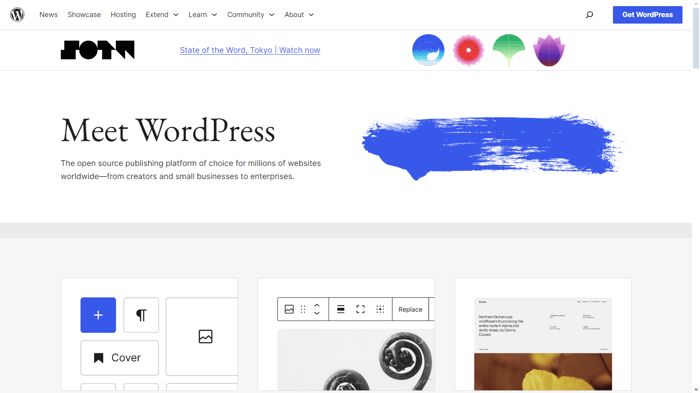
WordPress is one of the most widely used content management systems (CMS). The reason this CMS found its place among the best blogging platforms for SaaS companies is its flexibility. You can choose the themes, functionalities, and hosting for your blog, giving you complete control over it.
WordPress.org Key Features
Highly customizable blogging platform: WordPress is known for its design flexibility, allowing you to build your own theme or use a pre-built one. If you want to modify it, you can do that, too. However, you’ll need some coding knowledge to make these visual adjustments.
Large plugin marketplace: The WordPress experience includes more than 59,000 plugins you can add to your site and your blog, including 4,760 plugins for SEO alone. Luckily, there's likely a plugin for whichever functionality you want to add to your blog.
Multi-user support: WordPress has six built-in user roles, from super admins with full control to subscribers who can only view content. These roles let you easily manage access and permissions for your team.
WordPress.org Limitations
Plugin-dependent platform: If you choose WordPress as your SaaS blogging tool, much of its functionality will depend on plugins – you have to know which ones to use. Keep in mind that researching plugins takes time, and so does keeping them all up to date.
Complexity: Compared to other SaaS blogging tools, the self-hosted version of WordPress is far from beginner-friendly. If you haven’t used it before, you’ll need to spend some time learning about the platform’s interface and settings.
Requires technical knowledge: WordPress performance and security depend on good code, the right plugins, and reliable hosting—all of which require technical know-how or, at least, some basic technical awareness.
Basic SEO features: WordPress-powered blogs are partially optimized for search engines and use pages, posts, and categories to help search engines crawl your site. However, for advanced SEO features, WordPress requires a plugin.
Can’t be added to any website: When you create a WordPress blog, you can add it to your existing site – but only if it’s an HTML site or built with WordPress. If you already have a website elsewhere, you won’t find it easy to add your WordPress blog to it.
Limited support: WordPress users can reach out to other WordPress users for help. The platform’s community is indeed a large one, but that might not be sufficient if you need a traditional one-on-one approach.
Pros and Cons of WordPress.org
| Pros | Cons |
|---|---|
| ✓ Flexible blogging tool | ✗ Steep learning curve |
| ✓ Extensive plugin directory | ✗ Basic SEO features |
| ✓ Low starting cost | ✗ Community-only support |
| ✓ Customizable user permissions | ✗ Requires regular updates |
✗ Advanced blogging features require a plugin | |
| ✗ Blog performance depends on plugins and themes |
Ideal for users who already have a WordPress site and have the knowledge to leverage the platform’s customization flexibility.
3. Ghost
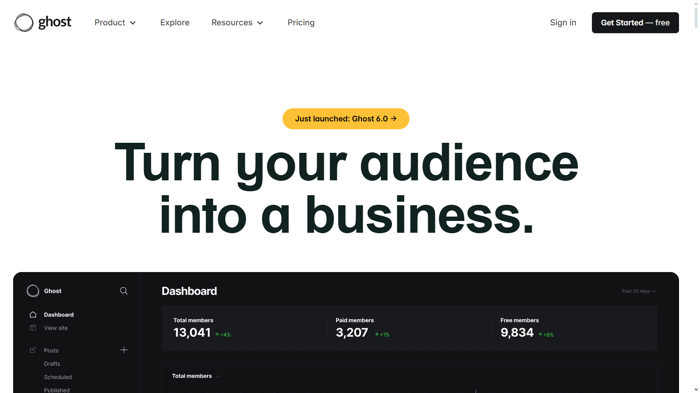
Ghost is a user-friendly version of WordPress, albeit with fewer settings and plugins. The platform is, like WordPress, open-source and flexible, but more focused on content creators who don’t need all the bells and whistles WordPress offers. It also has a hosted version (Ghost (Pro)), designed for those who want a less technical setup for their SaaS blog.
Ghost Key Features
A wide selection of blogging elements: The blogging platform has a feature called Cards, which are essentially the different blog elements it supports. These include call-to-action buttons, image galleries, and videos, all of which you can easily add to your blog without coding.
Email features: One of the platform’s notable features is that it lets you build a list of subscribers, segment them, and send your blog content via email. With the self-hosted version of Ghost, though, configuring your newsletters will require some technical know-how.
Multi-user support: Much like DropInBlog and WordPress, Ghost supports user roles out of the box, including contributors, authors, editors, and administrators. The restrictive part is that user permissions can’t be customized.
Built-in analytics: Using Ghost’s native analytics tool, you can gather insights about your website traffic and newsletters. Additionally, if you want to integrate your Ghost blog with another analytics tool, you can connect it with tools like Google Analytics.
Integrations: Ghost lets you integrate your blog with the tools you already use, featuring over 100 integrations. The integration list isn’t as extensive as that of WordPress, but you’ll still be able to find most of the tools you need.
Ghost Limitations
No easy way to add a Ghost blog to an existing website: If you already have a website, you’ll need to use Ghost’s API or do some custom coding to connect your Ghost blog to your website.
Small learning curve: Although Ghost is considered simpler than WordPress, it still has a learning curve. That is especially true for the self-hosted version.
No SEO analysis tool: Some blogging tools let you optimize your content by inserting keywords into it. Ghost isn’t one of those tools, and it offers the SEO features you’ll find with most platforms – meta tags, site maps, and canonical URLs.
Member-based pricing: Ghost’s lowest plan includes only 1,000 members. If you have more than that, you’ll have to subscribe to a more expensive plan. Keep in mind that Ghost’s plans also have other limitations, including bandwidth usage, staff accounts, and file upload size.
Pros and Cons of Ghost
| Pros | Cons |
|---|---|
| ✓ Supports various blog elements (images, videos, CTAs) | ✗ Basic SEO features |
| ✓ Supports memberships and gated content | ✗ Bandwidth limitations |
| ✓ Lets you create snippets (reusable content) | ✗ Member-based pricing |
| ✓ Built-in email features | ✗ No easy way to add it to an existing site |
| ✗ Adding a table of contents requires a JS library | |
| ✗ No text-to-speech feature | |
| ✗ The hosted version offers limited customization |
Ideal for blog owners who want a blogging tool with integrated email features and membership support.
4. Webflow
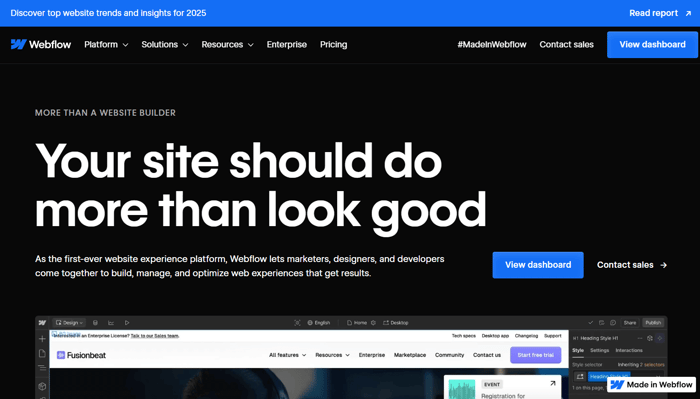
Webflow is one of the top no-code website builders. It lets you create visually stunning websites without any coding knowledge. If you want to add a blog to your Webflow site, you can do that with Webflow’s CMS collections and templates.
Webflow Key Features
No-code tool: Webflow writes your site's code behind the scenes, while you build and design your site via the drag-and-drop interface. Or, if you’re looking for a more beginner-friendly approach, you can also start with one of the thousands of pre-made templates,
Supports teamwork: This SaaS blogging tool comes with five user roles, ranging from site managers who have access to everything to reviewers who can only view and comment on sites. You can create custom roles, but for that, you have to be on Webflow’s most expensive plan.
Versatile app marketplace: Webflow websites, by default, have all the functionalities you need. Still, if you want to extend your site’s functionality, the platform’s app marketplace has over 300 apps that can help you with SEO, e-commerce, and analytics..
Webflow Limitations
Not the most intuitive blogging tool: Webflow is a no-code builder, but it comes with a learning curve. It has a plethora of customizations and features, which require some time to get familiar with.
CMS item limitations: The platform has a plan-based limit for the number of items in your CMS collection, ranging from 1,000 to 20,000. Once you go over it, you’ll need to transfer to a higher-tier plan – something that content-heavy sites won’t find convenient.
Confusing pricing structure: Webflow has Site plans (general and e-commerce) and Workspace plans (for teams and individuals). Given this type of pricing and the platform’s limitations, it may be challenging to track and stay within the budget.
Basic SEO: Webflow gives you a decent share of features to optimize your blog for search engines, including metadata, sitemaps, and redirects. However, if you do your own SEO and need guidance on keyword usage, you’ll need to install a separate app for it.
Pros and Cons of Webflow
| Pros | Cons |
|---|---|
| ✓ No-code builder | ✗ Steep learning curve |
| ✓ Highly customizable | ✗ Confusing pricing |
| ✓ A wide range of integrations | ✗ CMS item and bandwidth limitations |
| ✓ Supports components for site-wide updates | ✗ No text-to-speech feature |
Ideal for content creators and web designers who lack the coding skills to design a beautiful blog.
5. HubSpot CMS
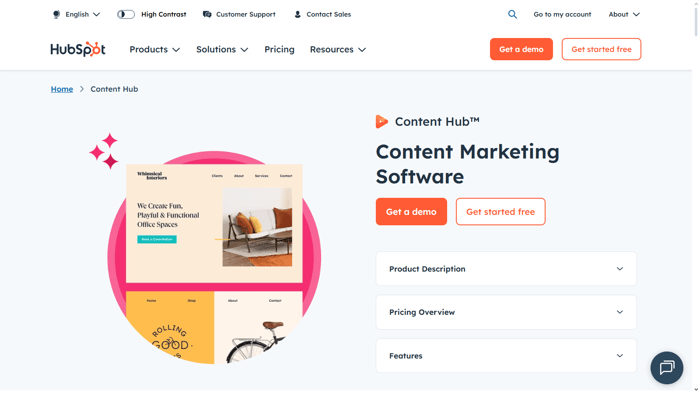
HubSpot CMS is a comprehensive, all-in-one content management system with over 250,000 users. It offers a range of tools and features for managing content, online sales, and email marketing. You probably know HubSpot as a marketing automation tool, but what you might not know is that it has a blogging engine, which is why it has found its place on this list of the best blogging tools for SaaS companies.
HubSpot CMS Key Features
Blog elements: HubSpot lets you add your content using the traditional post editor. Then, if you want to add lists, recent posts, comments, or products, you can do so by dragging and dropping them into the editing area. In other words, you can easily create blog content.
AI-powered tools: The platform has an AI-powered content creation tool to streamline content production. It also has a feature called Post Narration, which converts your blog posts into audio. To use this feature, you need to be on the Professional plan, which costs $6,000/year.
Content optimization best practices: HubSpot CMS also has a tool called Recommendations, which checks your content’s SEO title, meta description, image alt text, links, and word count. Additionally, HubSpot utilizes Semrush data to help you find the right keywords for your content.
Unified content marketing experience: The marketing platform is paired with its own CRM and analytics tools. This powerful combo lets you track your blog’s performance, including your top-converting content.
HubSpot CMS Limitations
Steep learning curve: HubSpot offers an abundance of features to help you run your blog. However, the feature-rich interface can be overwhelming, and to get the most out of this blogging platform, you’ll need to overcome its learning curve.
User permissions depend on a pricing plan: Another drawback of HubSpot is that while it supports multiple users and permissions, you can only create custom permissions on the platform’s most expensive plan – Enterprise.
Expensive: There’s no denying that HubSpot comes with a host of great blogging features. Still, to use features such as Post Narration and Smart Content, you’ll need to purchase the Professional or Enterprise plan, which ranges from $6,000 to $18,000.
Pros and Cons of HubSpot CMS
| Pros | Cons |
|---|---|
| ✓ Feature-rich blogging tool | ✗ Steep learning curve |
| ✓ Creates an audio version of your blog content | ✗ Expensive |
| ✓ Advanced SEO features | ✗ Limited features on the lower-tier plans |
| ✓ Built-in analytics | ✗ Not suited for small businesses |
Ideal for large SaaS companies that need an all-in-one solution for content management, marketing, CRM, and automation.
6. Medium

Medium is best known as a free blogging platform for those who don’t need to set up a website. Its main selling point is a large built-in audience, which gives new blogs more opportunities to surface in Medium’s feed.
Medium Key Features
Simple blogging tool: Medium’s core strength lies in its intuitive design. The editor supports images, videos, code blocks, links, and text, which makes creating content straightforward. Sometimes, however, adding a simple HTML table can be a challenging task.
Quick start: You don’t have to build your blog page. As soon as you create your Medium account, you can start adding your content.
Hosted blogging tool: Unlike WordPress and Ghost, Medium is a hosted platform, which means you don’t have to worry about the technical aspects of your blog. It lives on Medium’s servers, and all the security, backup, and update tasks are performed by the Medium team.
Medium Limitations
Limited SEO features: Medium allows you to add an SEO title and meta description to your articles, but that’s about it. You can’t optimize your content for your primary keywords with on-page guidance.
Limited design control: The design section in Medium lets you adjust blogroll and header settings. However, when your readers visit your blog, they’ll see Medium’s logo, and you can’t remove it. The other downside is that your blog probably won’t match the rest of your site.
Getting discovered can be challenging: If you’re a company like Netflix, your readers will probably find your blog easily. If, however, you’re building your audience, you’ll find that getting noticed on Medium isn’t easy at all.
Lacks integrations with third-party apps: The only three apps you can connect with your Medium account are Mastodon, X, and Facebook.
Not easy to add to an existing site: If you’ve already set up your site elsewhere, you can use Medium’s RSS feed to display your blog on your site. Alternatively, you can add a link from your main site to your Medium blog, which, like the first option, isn’t ideal from an SEO standpoint.
Pros and Cons of Medium
| Pros | Cons |
|---|---|
| ✓ Easy to use | ✗ Limited SEO features |
| ✓ Minimal setup | ✗ Limited customization |
| ✓ Built-in audience | ✗ No text-to-speech feature |
| ✗ Difficult to add to an existing website | |
| ✗ Few integrations |
Ideal for testing the content marketing waters and determining whether your company needs a blog.
Best Blogging Platforms for SaaS Companies Compared
| Integrations | SEO features | Customization options | Pricing | User support | |
|---|---|---|---|---|---|
| DropInBlog | Works with your existing tech stack | Built-in SEO analysis tool Customizable URLs, metadata AI SEO checker | Inherits your site’s design automatically Can be customized via custom CSS | From $49 | Responsive live chat and email support |
| WordPress | 59,000+ plugins | Basic SEO Requires plugins for advanced features | Extensive, but requires technical knowledge | Hosting + plugins + themes (anywhere between $100 and $1,000) | Community support |
| Ghost | 100+ | Basic SEO | Extensive, but requires technical knowledge | From $18/month | Email and community support |
| Weblow | 300+ | Basic SEO Requires third-party apps for advanced features | Extensive | From $18/month | Email and live chat support |
| HubSpot CMS | Around 2,000 | Advanced SEO features | Moderate | From $15/month | Email, live chat, phone, and community support |
| Medium | 3 | Limited | Limited design options | From $5/month | Email support |
Why DropInBlog Is the Best Blogging Tool for SaaS Companies
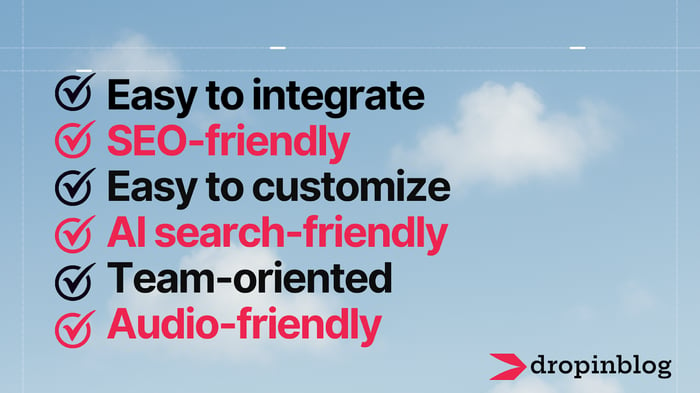
Here’s why SaaS teams choose DropInBlog:
Fast setup – Add DropInBlog to almost any site in minutes
SEO built-in – Built-in SEO guidance to boost organic traffic
Mention Boost™ – Make your content AI-friendly and future-proof
Blog Voice AI™ – Instantly turn blog posts into audio for richer content engagement
Smart Snippets™ – Keep content consistent across your site
Team-friendly – Assign roles, manage permissions, and scale your blog as you grow
Design flexibility – Inherits your site’s look with zero design drift
While other platforms force you to compromise between control, complexity, and customization, DropInBlog gives you all three.
Try DropInBlog for free and start building your SaaS blog in minutes.
Happy SaaS blogging!


